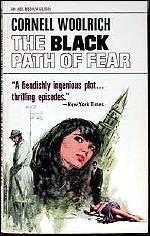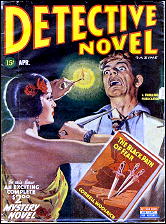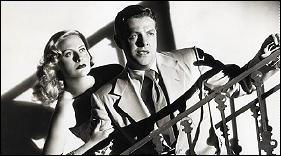Sat 17 Feb 2018
A Book! Movie!! Review by Dan Stumpf: CORNELL WOOLRICH – The Black Path of Fear / THE CHASE (1946).
Posted by Steve under Mystery movies , Reviews[13] Comments
CORNELL WOOLRICH – The Black Path of Fear. Doubleday Crime Club, hardcover, 1944. Reprint editions include: Detective Novel Magazine, April 1945; Avon #106, paperback, 1946; Ace H-66, paperback, circa 1968; Ballantine, paperback, 1982.
THE CHASE. United Artists, 1946. Robert Cummings, Michele Morgan, Steve Cochran and Peter Lorre. Screenplay by Philip Yordan, from the novel The Black Path of Fear, by Cornell Woolrich. Directed by Arthur Ripley.
Woolrich at his pulpiest turned in to film noir at its weirdest. Such a treat!
As the book opens, Bill Scott and Eve Roman are just arriving in Havana, fleeing from her husband, gangster Eddie Roman. By the end of the first chapter, she will be dead and he’ll be framed for her murder, which is a lot to pack into one chapter, but Woolrich doesn’t skimp on atmosphere or color as the plot rushes on. He writes about a crowded bar in a way that had me tucking my elbows in, and there’s a very atmospheric chase scene from the fugitive’s POV up a darkened stairway, lit only by the flashlights of his pursuers.
In a typical Woolrichian coincidence, Bill hooks up with a street-smart Cuban Miss named Midnight with a grudge against cops that impels her to help him track down the real killers. And once again we get that superb atmosphere of darkened doorways, twisted streets, and even into the bowels of an opium den, painted in fevered but fast-paced prose. And for a conclusion there’s a knock-down drag-out fight scene, and a bitter, romantic coda Chandler might have envied.
Black Path was filmed in 1946, and before I go into it, perhaps a word about the film’s creators might be helpful:
Producer Seymour Nebenzal was a big name in the early German cinema, with films like M and 3-Penny Opera on his resumé . After he fled Germany to the U.S. his films went into a “cheap-but-interesting†period of things like Hitler’s Madman, but he did produce remakes of his German films Mistress of Atlantis and M.
I have heard passing references to director Arthur Ripley before; UImer referred to him as “a sick man, mentally & physically” and his output was meager, with a few films that had to be finished by other hands. He was apparently a man of ill health and gloomy outlook, who worked most of his early career in comedy for Mack Sennett, Harry Langdon and W.C. Fields (he directed Fields’ classic short Barber Shop.)
After many years as a gag man for Capra and others, Ripley directed Voice in the Wind, The Chase, and part of Siren of Atlantis, then nothing till Robert Mitchum asked him to direct Thunder Road. Damn Strange if you ask me.
Together Nebenzal and Ripley make The Chase something unique, aided by photographer Franz Planer (who sent on to Breakfast at Tiffany’s and The 5,000 Fingers of Dr. T) and a choice cast that includes Steve Cochran as an acquisitive gangster and Peter Lorre as his matter-of-fact executioner, who gripes about sending flowers to the funeral of their late competitor (“A hundred and fifty bucks. I don’t care what you say, that’s inflation.â€)
Narrative-wise, The Chase is something else again. It follows the book pretty faithfully for the first half, then Ripley and writer Philip Yordan apparently decided to leave off and make another movie about the same characters. There’s a scene of shocking surprise, followed by a trite “cheat,†and all at once we’re into a movie where Bob Cummings is a disturbed vet with fits of amnesia.
It’s to the credit of all concerned that this works as well as it does. As I watched, I found myself going from “Aw c’mon!†to “Come on, snap out of it, Bob – and hurry!†as the characters from the first half of the film move toward and away from what looks like predestined fate.
The Chase can’t be called a complete success, but it has its moments, and I guarantee it’s one of the strangest you’ll ever see.






February 18th, 2018 at 1:21 am
Great book and interesting movie. It was adapted twice on SUSPENSE, once with Cary Grant and once with Brian Donlevy.
The film version has quite a few dreamlike qualities, and as you suggest takes some odd turns.
February 18th, 2018 at 4:03 pm
I haven’t read the book since I was 18, but at the time, I thought it was the best book I’d ever read. Time for another reading, I think.
What’s strange is that I don’t believe I’ve ever heard of the movie before. I know I’ve never seen it. It’s time to remedy that, too.
February 18th, 2018 at 8:21 pm
Howdy! How are You all? Sorry it has been a few weeks since I did not come here, because I was sick and still unwell, I think I will have to go to the Family Doctor again. I saw the movie a couple of years ago online, do not know if it is still available.
It was a different movie, everything that Peter Lorre was in, was always strange in some way and enigmatic at the same time. Again, great review and take good care and God be with You All.
February 18th, 2018 at 9:04 pm
Serge
Good to hear from you again. Glad all is well.
The movie currently available on DVD. I know because I have a copy currently in my Amazon shopping cart, just waiting for me to accumulative items to qualify for Free Shipping.
And now that you mention it, I think I will do something soon to hurry that up. Lest anyone worry, that is very very easy to do.
February 19th, 2018 at 8:21 am
Mine is on a double-bill with BURY ME DEAD.
February 19th, 2018 at 9:51 am
A very good and informative review. You say many things about the book and how the movie is both faithful and not so faithful to that book. For some such as myself who has neither read the book or seen THE CHASE or any of the other adaptations you satisfied enough of my curiosity to cause me to want to see the movie without giving away so much as to ruin it. A fine job. Thanks.
February 19th, 2018 at 11:48 am
Steve, I think you mean “accumulate” not “accumulative” in comment 4. Frankly, I never thought of waiting to put together an order until I had enough in my Amazon shopping cart to get free shipping. I’m always afraid I may forget what I’ve ordered and why I’ve ordered it … like Netflix, I can’t always remember why I wanted each movie.
February 19th, 2018 at 12:14 pm
I’ll blame AutoCorrect for the spelling mistake. Wish I’d caught it myself.
It doesn’t take a huge total to get Free Shipping on Amazon, and I’ve already done so. Beats paying $3.99 per item!
February 19th, 2018 at 11:51 am
And in the 8th paragraph in Dan’s review you have spelled Mack Sennett without enough letters!
February 19th, 2018 at 12:15 pm
That one I’ll fix, ASAP. Thanks!
February 20th, 2018 at 4:29 pm
As a result of reading this very informative review, I’ve just watched this movie. It is available on UCLA film archive in a digitally restored version. The UCLA version is also available through YouTube. The restoration is superb. As to the film, the emphasis on atmosphere slows down the pace of the film quite a bit. Having said that, I did enjoy it.
February 20th, 2018 at 5:44 pm
Uh, oh. Thanks for this, Moe. I don’t think the one I’ve ordered is the UCLA version. I didn’t pay much for it, so it’s probably a public domain copy in awfully iffy shape. We’ll see. It should be here in about a week.
November 7th, 2018 at 9:14 pm
[…] Mystery*File […]